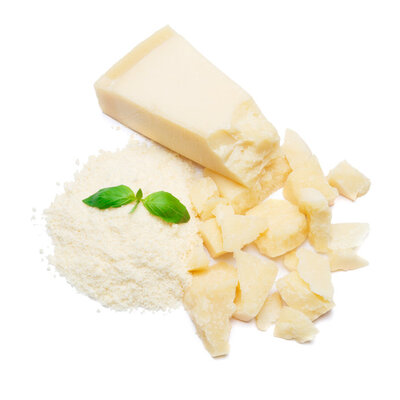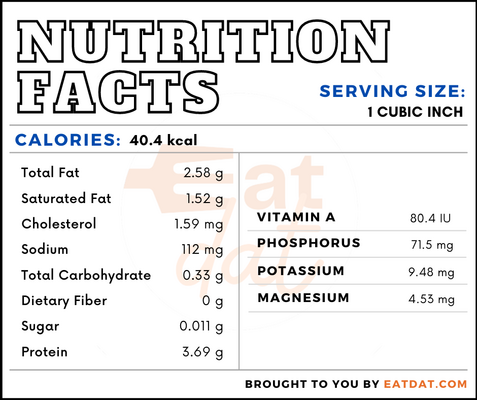
Parmesan
also known as Parmigiano-Reggiano
What is Parmesan?
Parmesan cheese is a hard cheese produced only in Italy. Its name comes from the provinces of Reggio Emilia and Parma, which are the main parmesan-producing areas in Italy.
- As Parmigiano-Reggiano is certified as Protected Designation of Origin (PDO) it can only be produced in Italy, while parmesan is the name given to cheeses that may be produced elsewhere.
- This cheese is rich and has a sharp, salty taste with hints of sweetness and nuttiness.
It has a hard rind that is golden in color and a lighter interior. This cheese has gained the epithet of being the king of cheeses.
The top 10 most popular parmesan cheese brands in the United States are:
- Kraft
- Milano’s
- Caseificio
- Igourmet
- Andrew & Everett
- Mama Francesca
- Alma Gourmet
- Consorzio Vacche Rosse
- Olio & Olive
- BelGioioso
Origin of parmesan
This cheese has its origins in Italy in the Middle Ages when Benedictine and Cistercian monks developed a new cheese that had a long shelf life. They made the cheese using salt from the Salsomaggiore salt mines and milk from the locally bred monastery cows. The first written evidence of Parmigiano-Reggiano is around 1254 in Genoa. Later on, the Italian Renaissance saw this cheese becoming better, produced on a larger scale, and more popular in the surrounding areas and countries. This led to the Duke of Parma Ranuccio I Farnese to create a designation of origin in 1612, the first of its kind in Europe.
Nutrition
Nutritional profile for parmesan cheese (1 cubic inch):

Furthermore, parmesan contains micronutrients such as calcium,selenium, choline, retinol, carotene, vitamin D, and essential fatty acids. Also, it contains prebiotics and probiotics.
This cheese helps in aiding digestion and despite being made with cow’s milk, is suitable for lactose intolerant people. Moreover, the high amount of calcium in the cheese helps in building bone strength and prevents osteoporosis. Some elements found in parmesan are used in immunotherapy for HIV/AIDS. In addition, regular consumption of parmesan may help in reducing the risk of diabetes, gastrointestinal problems, obesity, hypertension, cardiovascular diseases, and colon cancer.
Commercial production
Parmigiano-Reggiano is produced by using fresh milk from cows. The process of cheese making starts within two hours of milking. First, the milk is left overnight in vats, which separates the cream. Then, the skimmed milk is mixed with full cream milk and heated up, to which a whey starter is added.
Rennet is also added, allowing the milk to curdle. Next, the curdled milk is whisked into smaller granules, from which moisture is removed by cooking. After that, the granules sink to the bottom and form a cheese mass, which is then immersed in salt water and aged for at least 12 months. For parmesan made outside the protected region, the production procedure is similar but is not so strictly followed in most cases.
Parmesan recipes
There are many ways to use parmesan. It is often grated as a topping on pastas, risottos, and pizzas. Also, it may be used to top baked goods, soups, and vegetable dishes. Here are some recipes to try:
- Eggplant Parmigiana
- Cacio e Pepe
- Risotto
- Baked Tomatoes
- Minestrone Soup
- Cheese Bread
- Roasted Cauliflower
- Cheese Souffle
- Baked Asparagus
- Tomato Basil Quiche
FDA regulations
Parmesan cheese or reggiano cheese is defined by the FDA as the food prepared from milk and other ingredients characterized by a granular texture and a hard and brittle rind, which can be grated. It must contain at most 32 percent moisture and at least 32 percent milk fats and must be cured for at least 10 months. Cheese designated as Parmigiano-Reggiano may only be produced in Italy since 1996 in the provinces of Parma, Reggio Emilia, Modena, Bologna to the left of the Reno river, and Mantua to the right of the Po river. The product is certified by a protected designation of origin (PDO).
References
Larry Omsted, The King Of Cheeses: Why Does It Taste So Good?, Forbes, https://www.forbes.com/sites/larryolmsted/2012/11/16/the-king-of-cheeses-why-does-it-taste-so-good/?sh=59db7db263ea
The History: A Journey of a Thousand Years, Parmigiano Reggiano Consortium, https://www.parmigianoreggiano.com/product-history
Pampaloni, Barbara et al. “Parmigiano Reggiano cheese and bone health.” Clinical cases in mineral and bone metabolism : the official journal of the Italian Society of Osteoporosis, Mineral Metabolism, and Skeletal Diseases vol. 8,3 (2011): 33-6., https://www.ncbi.nlm.nih.gov/pmc/articles/PMC3279064/
Summer, Andrea et al. “Cheese as Functional Food: The Example of Parmigiano Reggiano and Grana Padano.” Food technology and biotechnology vol. 55,3 (2017): 277-289. doi:10.17113/ftb.55.03.17.5233, https://www.ncbi.nlm.nih.gov/pmc/articles/PMC5654426/
